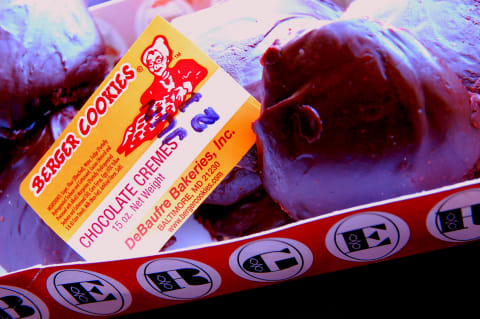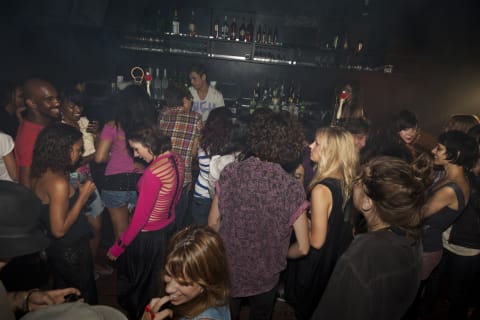17 Baltimore Slang Terms You Should Know

Baltimore is one of the east coast’s hidden gems. It’s the birthplace of the U.S. national anthem, the setting of pop culture classics like Hairspray and The Wire, and full of incredible food, culture, and people. Charm City’s namesake charm could partially be due to the locals’ broad vocabulary of slang. Here are some terms you should know if you ever plan on visiting.
1. Bawl-mer/Bal-da-more/B-more
Baltimore tourists may pronounce the city’s name with three equally stressed syllables, but local pronunciation can vary from block to block. According to Dr. Christine Mallinson, professor of language, literacy, and culture at the University of Maryland, Baltimore County, Black Baltimore natives pronounce the city name “Bal-da-more,” while white natives tend to say “Bawl-mer.” The abbreviated “B-more” is a good compromise if you’d rather not choose between the two.
Whichever nickname pronunciation you use, there’s a good chance the locals will have you clarify whether you’re referring to Baltimore City or Baltimore County. Contrary to what some may believe, the city isn’t part of the county, but is instead treated as its own county-equivalent jurisdiction in the state of Maryland.
2. and 3. (The) DMV and the MVA
If you visit Baltimore (City, County, or both) and some of its neighboring areas, it might sound like a lot of people are having issues with their car registration based on how much the DMV comes up in conversation—but what they’re actually referring to is an area, specifically Washington D.C. and the adjacent counties in Maryland and Virginia, that can be reached with the D.C. metro system. That said, though city residents use the nickname, Baltimore isn’t considered part of the DMV.
If a Baltimorean or DMV resident is looking to get their license renewed, they’ll make a trip to the MVA (motor vehicle administration).
4. O’s
Baltimore’s local baseball team, the Baltimore Orioles, are known as the O’s throughout the state of Maryland. Should you get the chance to watch an O’s game in Oriole Park at Camden Yards, make sure to do as the locals do and emphasize the “O” in the line “Oh say does that star-spangled banner yet wave ...”
5. and 6. Yo and Ayo
The word they has been used as a gender-neutral singular pronoun for hundreds of years, but Baltimore youth recently started using a new pronoun that serves the same purpose. Yo can refer to anyone in the third person (“I saw yo at the O’s game”) regardless of a person’s gender and in tandem with gendered pronouns (“Yo said she’s from the DMV!”).
Yo rose to popularity among Baltimore City school children around the early 2000s. After observing the use of the word among students, Elaine Stotko, a linguistics professor at Johns Hopkins University, and Margaret Troyer, a Baltimore City teacher, developed a preliminary study, published in 2007, that analyzed the use of the word in context. They found that students would typically use yo to refer to peers as opposed to adults, as calling an adult “yo” is considered impolite. The study also showed that yo’s usage as a pronoun was almost exclusively local to Baltimore.
Many people outside of Baltimore also used the word yo at the time, and still do to this day, though it isn’t used as a pronoun—it’s used as a greeting, or to get someone’s attention. Baltimoreans will use the two-syllabled ayo to serve that purpose.
7. Hon

The “Bawl-mer” side of the city has a different gender-neutral term. Hon is an affectionate name for someone—be that a friend or a stranger—which is derived from the word honey. Unlike yo, it’s typically used in the first person, and can also be used as a verb (as in, “a nice lady just honned me,” meaning she called you “hon”) or a noun, referring to a beehive-sporting woman who looks like she just walked off the set of Hairspray.
Hon culture has become quintessential to a certain demographic of Baltimoreans, but that cultural prominence has seen its fair share of controversies. In the ‘90s, there was a series of graffiti offenses by an elusive Baltimore resident who became known as the “Hon Man.” Every so often, the Hon Man would use white paint to edit the “Welcome to Baltimore” sign on the Baltimore-Washington Parkway into “Welcome to Baltimore, Hon.” Though some locals loved it, vandalism is vandalism, and Baltimore City officials repeatedly removed the paint before finally nabbing the Hon Man in 1994. This sparked a debate. State senator Barbara Hoffman fought for the city to permanently add hon to the sign, while another state senator, Larry Young, argued that Hon culture wasn’t representative of all Baltimore residents, and lobbied for bro to be added instead. Ultimately, the sign remained “Welcome to Baltimore,” with no friendly-sounding addition.
The linguistic divide between Baltimore’s Black and white demographics may be a side effect of location. The primarily Black “Bal-da-more” yo users can be found in a majority of Baltimore City neighborhoods, while the white “Bawl-morean” hon crowd is more concentrated in longer-established white neighborhoods like Highlandtown, Hampden, and Locust Point. Hampden even holds an annual “HONfest,” with food stands, vendors, and the “Best Hon Contest,” which awards the title of Baltimore’s Best Hon to whoever can pulls off the most convincing “hon” look.
8. Dummy
If a Baltimorean calls you “dummy,” don’t immediately try to pick a fight. What sounds like an insult to most people is so ubiquitous as a Baltimorean term of endearment that a local musician featured the word in a 2020 anthem about the city’s unique slang. Dummy is commonly used as an amiable greeting among friends and acquaintances, often preceded by “hey,” “hi,” or “what’s up.” However, dummy is contextual, and throwing the word around without ensuring a mutual understanding could make a social interaction go south.
9. Berger Cookies

If you’re feeling peckish, you can’t go wrong with a classic Berger cookie—cake-textured treats slathered with a thick layer of rich, fudge topping. The cookies were created by Henry Berger, a German immigrant who opened a bakery in East Baltimore in 1835. Since then, they’ve become a beloved Baltimore staple. They’re so synonymous with Baltimore eats, in fact, that Whole Foods started selling a copycat version called the “Charm City Cookie.” The move was met with controversy from locals, who insist that the Amazon-owned company should buy directly from the bakery instead of making a knock-off.
10. Snowball
Another iconic Baltimore treat is the snowball, which consists of a base of crushed or shaved ice topped with a flavored syrup. Snowballs date back to the 1800s (and went by names like “penny sundaes” or “hard-time sundaes” during the Great Depression), and originally, the syrup was made from eggs and sugar. These days, though, there’s a more expansive offering of flavors, including the fruity, red-hued “Tiger’s Blood,” and “Skylight,” which is simply described as “blue flavor.” Some snowball makers add some marshmallow fluff for a more decadent version.
11. Natty Boh

The National Brewing Beer Company began brewing National Bohemian-branded beer in Baltimore in 1885. Then, just five years after the Virginia brewing company Kreuger began offering the first canned beer in 1935, National Bohemian created the first 6-pack. The beer company took things to the next level in the 1950s, after president Jerold Hoffberger acquired ownership of the Baltimore Orioles and began distributing National Bohemian beers at O’s games. This helped popularize the beer so much that it became known as the “official beer of Baltimore” in the 1960s. Though it’s no longer brewed in Baltimore City, the lovingly-nicknamed “Natty Boh” remains a Baltimore institution.
12. Half and Half
For most restaurants outside of Baltimore, it’s an “Arnold Palmer,” but for Baltimoreans, that drink consisting of half lemonade and half iced tea is aptly named “half and half.” The primary difference between the Baltimore version and the one named after the golfer is that the Charm City version substitutes unsweetened iced tea for sweet tea.
13. Move(s)

Though this one isn’t Baltimore-specific and has become popular in other cities (including Memphis), Baltimore locals often ask “what’s the move” when the night is young and they’re down to do something fun. The question essentially translates to “what’s the plan?” or “where do you want to go?” Whether that move is the famed National Aquarium or one of Baltimore City’s many art museums, there’s always a move in Charm City.
14. Bop
A bop might refer to that catchy song you heard a local band play at Rams Head Live, but if you’re in Baltimore, it could also describe something that’s a significant distance to travel. If the moves are a bop away, that typically implies that it’s not worth the trouble to try to go.
15. Crouchy

Even if the moves are less than a bop away, you might end up changing the plans if the place is too crouchy—that is to say, if it’s excessively crowded.
16. and 17. Bet and Aard
Bet is used as a positive affirmation synonymous with “yes” or “sounds good”; according to Dictionary.com, the word rose to popularity in the 1980s and ’90s with likely ties to Black culture, and it was registered to Urban Dictionary as a slang term as early as 2003. While there is some debate over which U.S. city had the biggest hand in popularizing the word (New York and Atlanta have both been cited), it’s been a popular slang term in Baltimore for years.
Like many frequently-Googled slang terms with origins in African American language and culture, bet rose to popularity through the internet in the late 2010s, and has since been dubbed Gen Z slang. In Baltimore, bet is typically preceded by aard, which is a Baltimorean phonetic spelling of “all right.”